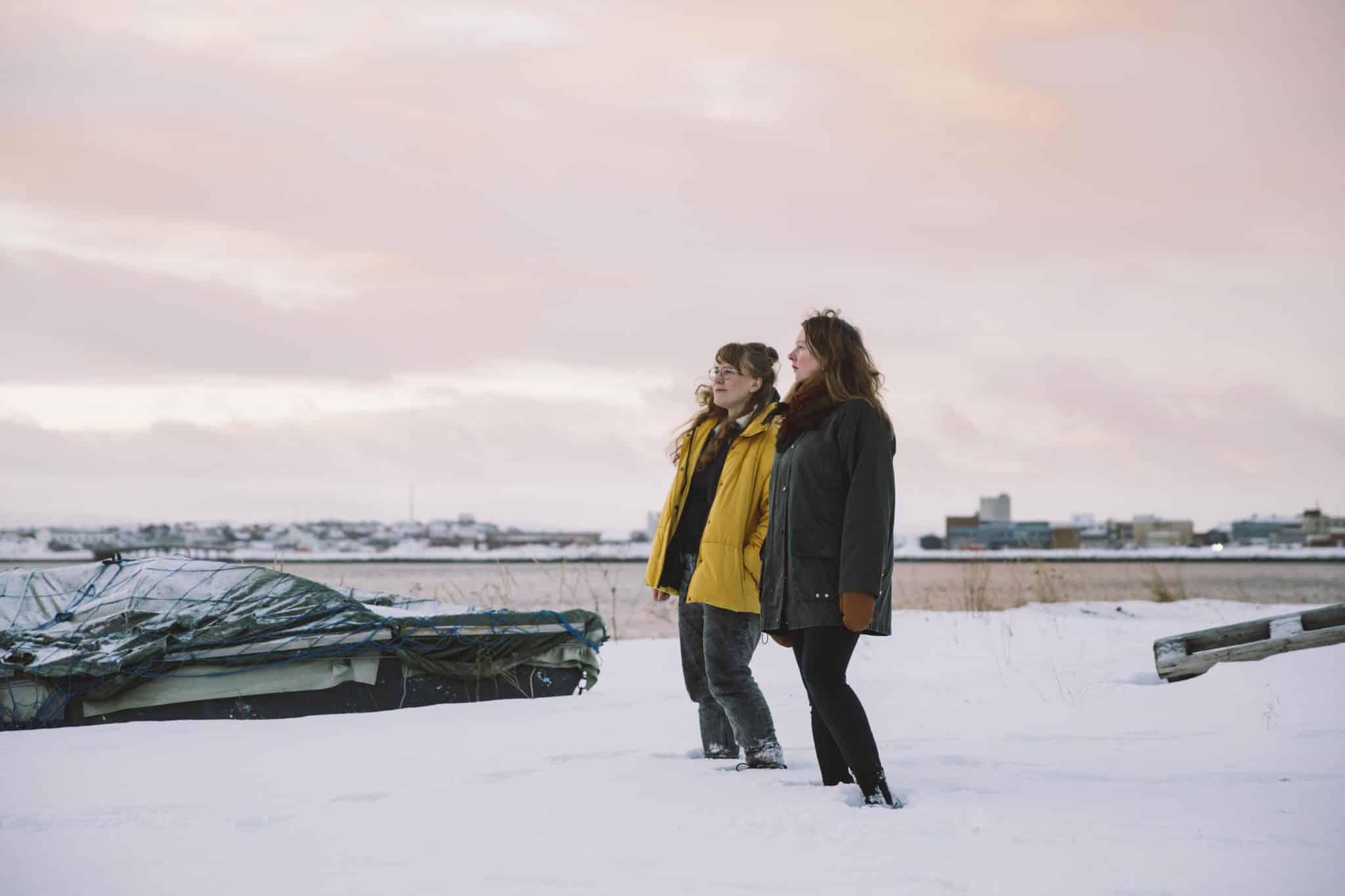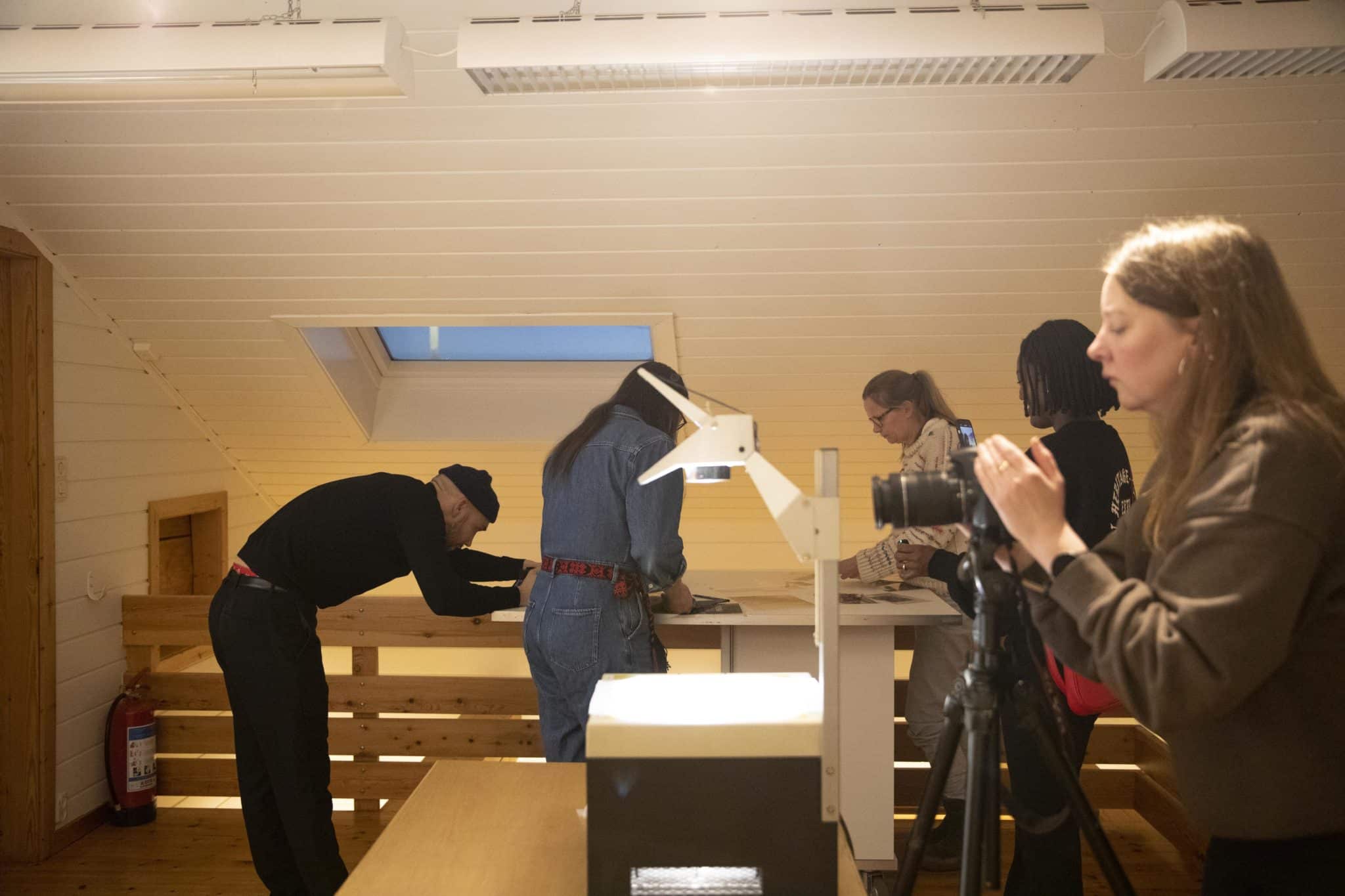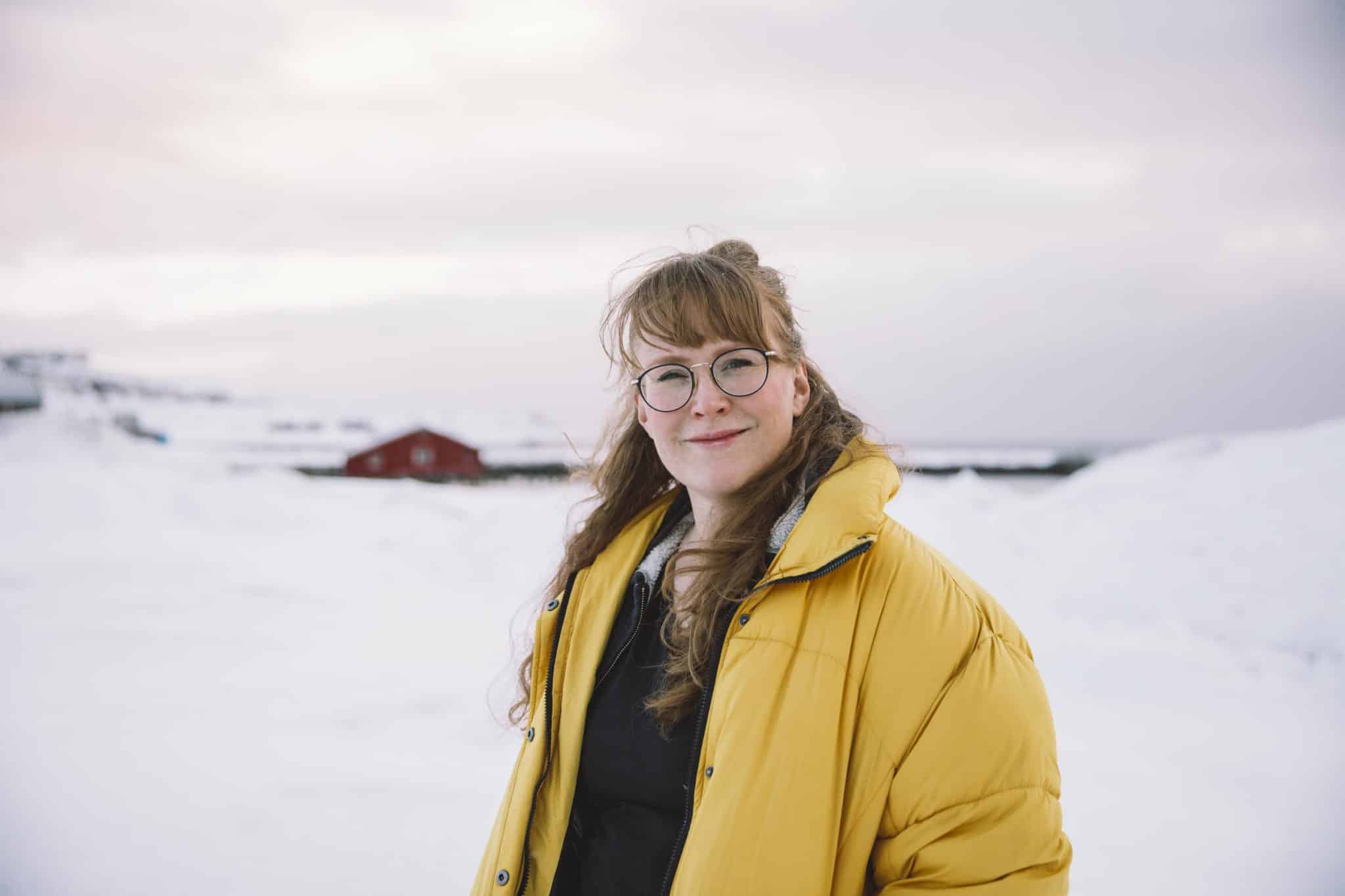Publisert 27.02.2023

Miina Alajärvi and Kirsikka Paakkinen. Photo: Sunniva Tønsberg Gaski/ Vadsø Art Association
Artists Miina Alajärvi and Kirsikka Paakkinen began their two-week long residency at Vadsø Guest Studio in mid-January. At the end of the residency, the artists reflect on what the time and space has offered for them, and on their project Vadsø Megacity.
«There’s a chance that areas in the North that we’re used to being sparsely populated might change drastically. Though the project is local, the topic is universal.» Miina Alajärvi
Your project imagines a future scenario where the Vadsø area becomes a home to hundreds of thousands of people because of the climate crisis. Through this, the project aims to find new perspectives on the local home environment. Where did you get the idea for the project?
Kirsikka: The open call Deep Water sought projects that address the challenges created by urbanisation in the northern regions and places like Vadsø. Right from the start we wanted to turn this scenario around. We wanted to explore what kind of thoughts and reactions people would have if the exact opposite of this trend were true.
Miina: One of the foundations for the project is scientific studies about mass migration within the coming decades. It is a fact that the climate crisis is forcing people to relocate. There’s a chance that areas in the North that we’re used to being sparsely populated might change drastically. Though the project is local, the topic is universal. The Vadsø Megacity art project imagines a reversal of the current trend of people moving to bigger cities and leaving Vadsø.

During the residence, locals in Vadsø were invited to take part in an open workshop.
Your project consists of a visual workshop and an exhibition. In the workshop you invite local participants to think how they would like to develop the city using collage and imagery as tools. Could you describe the process?
Kirsikka: The idea of the mega city for us is a catalyst for igniting people’s thoughts, emotions, and reactions. It’s asking one to take a stand, to position themselves in relation to this almost absurd proposition. It allows one to dream big or pause and look back at the things they appreciate here and now.
We held three workshops in January. We printed images related to Vadsø and Finnmark, futuristic cities, sustainable technologies, environmental problems, the cultures of the area, and so forth, on transparent films. We wanted to build a large media bank of images for the participants to choose from for their collages. They could also send us images to print for them beforehand.
Miina: Part of the process has also been interviews with people in different positions in the community. We wanted to talk with people who might have different perspectives on the topic. Excerpts from these talks will be presented in the forthcoming exhibition.
The process is ongoing. We’re building an exhibition for the Vadsø Kunstforening art gallery and we’ll hold two more workshops during the Varanger festival. The images produced in these workshops will also be part of the gallery exhibition. Hopefully the piece will help visitors to imagine alternative future prospects.
Vadsø Megacity invites people to look at their home town and provides a sneak peak of an imagined future. What kind of reactions did the question generate?
Kirsikka: I think the question generated a lot of responses, and almost always some kind of emotion or excitement, whether people wanted a bigger city or not. There were many who did not want a mega city at all, some that wanted a slightly larger city, and some that would welcome a big change. It seemed to be a question that engaged people. One’s home and the environment around it are at the core of our wellbeing. I think that was also reflected in the reactions, despite how people felt about the proposition, they seemed pleased that the focus was on Vadsø and its future.

Kirsikka is a filmmaker and visual artist from Rovaniemi in Finland. She graduated with an MFA in Film from HDK-Valand in Gothenburg, Sweden in 2021. Her graduation film When the Mill Hill Trees Spoke to Me has been screened at several festivals in Europe and won the Films For Our Future Award at the Lucca Film Festival. Small rural places are dear to her heart, as she grew up in one. Her childhood experiences of nature are perhaps the biggest influence for her art.

Miina is a filmmaker and media artist from Rovaniemi in Finland and works in independent and commercial fields of film. She works with documentary and community art projects as she never gets tired of listening to people’s stories. Miina works actively to organise media art events and projects and forge networks in northern Finland through her role on the board of Magneetti, the northern media culture association.
You have been working with both film and community arts in your recent projects – how do you see film as a tool for engaging communities?
Kirsikka: Film presents itself as a powerful medium and it can surely be that. Though the camera depicts just a fraction of a given moment and through a subjective lens, it’s perceived as an omniscient tool, as David MacDougall says, recording “not the images of events, but the events themselves.” In Vadsø Megacity we’re using such a tangible technique of mixing and matching and blurring images so that realism has no option but to fade into the background and imagination to step forwards. I like that.
Miina: Film can be a tool for community art in many ways. For example, it can be a way to document statements which might otherwise be cast aside. Or about learning a way to tell your own stories with the language of cinema. It can also be more delicate as in Vadsø Megacity. The communication within the images do not seem quite so direct, but as a reflection of community members’ mind flow.
«In Vadsø Megacity we’re using such a tangible technique of mixing and matching and blurring images so that realism has no option but to fade into the background and imagination to step forwards.» Kirsikka Paakkinen

Local participants at Vadsø Megacity workshop were invited to think how they would like to develop the city using imagery as a tool. Participants created collages by choosing different images and assembling them on an overhead projector. Each collage was then photographed by the artists.
«I think the question generated a lot of responses, and almost always some kind of emotion or excitement, whether people wanted a bigger city or not. There were many who did not want a mega city at all, some that wanted a slightly larger city, and some that would welcome a big change. It seemed to be a question that engaged people.» Kirsikka Paakkinen
The workshops in Vadsø have had various participants from young people to municipal decision makers. What kind of response did you get, and how did the project resonate amongst them? Did their visions on the future Vadsø Megacity differ and how?
Kirsikka: I noticed in all groups who participated and who we talked with a big appreciation for nature in Vadsø. That was something in common with almost everyone and it resonated in the images and in the things people imagined for the future megacity.
Miina: It was interesting to work with these different groups. In one of them, no one was born in Vadsø, but ended up there for one reason or another. In the youth group, they were all born in Vadsø and had lived there for their whole life so far. There were also people who have migrated back to their home town after living in bigger cities. Although they all had different perspectives on the area, there seemed to be many similarities as well. Home is a strong connector. We’re very much looking forward to meeting new people in forthcoming workshops. One of the workshops will be for kids so there will be very new perspectives I’d imagine.
How do you reach local communities, as a community artist? How do you build trust and how does the process work?
Miina: We see the project as a collaboration and co-creation with a local community. However, our role as community artists in this case is being outsiders reaching out to the community. It’s not a given that the community will welcome us and our odd claims of a future vision. We could only be open and sincere and respect the people we met. We were happy to find open -minded people with a willingness to engage in imaginative play for future prospects.
Kirsikka: It was quite easy for us to come to Vadsø and start the project because of all the help and guidance we got from Vadso Art Association and Monica Milch Gebhardt. I think our journey would have been very different without that collaboration and relationship. There was very quickly a strong sense of trust between us, and I felt like we could rely on our local partners for help and support. But it also requires that we as community artists have a curious and open attitude.
«Hopefully the piece will help visitors to imagine alternative future prospects.»
Miina Alajärvi
Vadsø Megacity will take place during the Varanger festival in August 2023. What are your expectations for it?
Kirsikka: I feel like the project hatched when the residency started and then just kept growing. It was amazing to see our idea come to life, and it couldn’t have happened without a very active and welcoming community that “adopted” our project and us. Now it truly feels like something that belongs to the whole community and lives on because of that.
We expect to delve deeper into our project and have lots of conversations about the topic and the works. Hopefully people will be active and curious, and come to see the exhibition and get involved. We’re also looking forward to the festival and returning to Vadsø, meeting our new friends, and seeing the area in another season!
The project Vadsø Megacity was selected by way of an open call in September 2022, launched in collaboration between Vadsø Art Association, FINNO, the Varanger festival, Vadsø guest studio, and the Artists’ Association of Lapland. Titled DEEP WATER, the call sought project proposals that address the relationship between art and culture, and a sustainable and viable regional society. The emphasis was on community-engaged art and cross-border collaboration in the northern regions of Norway and Finland. Vadsø Megacity will take place during the Varanger festival in August 2023.